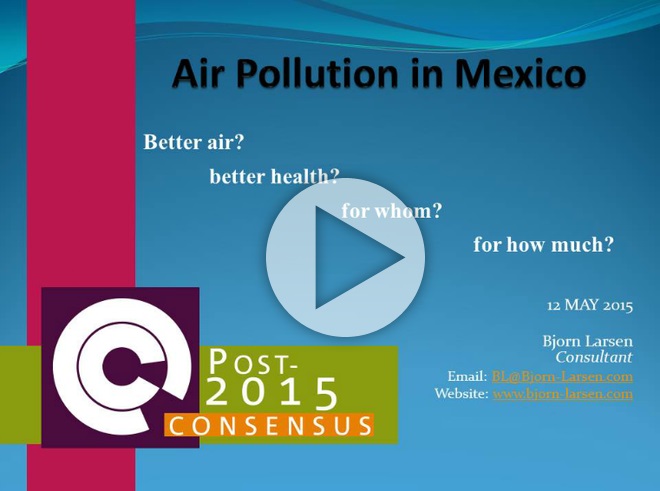Mexico Perspective: Air Pollution
Click here for information in spanish.
Background
According to the World Bank, air pollution kills nearly 33,000 Mexicans every year. Nearly 20,000 of these deaths are due to outdoor air pollution, mainly in towns and cities. The remaining 13,000 are from household air pollution, caused by cooking with wood and other solid fuels. This affects mainly rural communities.
In both cities and countryside, the cause is the same: tiny particles in smoke which we breathe in and which can lead to chronic lung disease and acute respiratory infections, lung cancer, heart disease and strokes. This does not just affect Latin America, but is a global problem causing over 6 million deaths worldwide each year.
Air pollution is a real problem in Mexico, causing about one in 17 (5.9%) of all deaths in the country. It is the eighth largest cause of death, after factors such as diet, overweight, high blood pressure, alcohol and drugs, smoking and lack of exercise.
The most dangerous of the airborne particles are known as PM2.5 (particulates less than 2.5 thousandths of a millimetre across) which can penetrate deep into the lung. The World Health Organization (WHO) has set a limit for average outdoor ambient air pollution of 10 micrograms (thousandths of a gram) of PM2.5 per cubic metre of air (10µg/m3). However, average concentrations in Mexico City are about 25µg/m3, and in the range 20-36µg/m3 in Puebla, Toluca and Monterrey.
This level of pollution is moderate, but at least 10,000 lives a year could be saved by reducing outdoor ambient PM2.5 concentrations to 15µg/m3, the interim WHO target. But this would be far more expensive than saving similar numbers of lives by reducing indoor air pollution.
Over 16 million Mexicans – more than one in every eight – cook primarily with firewood or charcoal and many households use them as secondary fuels. Pollution levels in these rural households can be 6-15 times higher than in urban areas and this can severely damage health. For the person doing the cooking, concentrations of PM2.5 in the air breathed in are 11-26 times higher than the WHO recommendation.
Simply replacing open fires and traditional stoves with improved cookstoves with chimneys reduces this exposure by half, but the average remains about 80µg/m3, still eight times the recommended limit. To make greater improvements, households need to make the transition to the more expensive propane (LPG). Use of gas as the primary fuel is a key reason why urban areas are less polluted. If all rural households used LPG, pollution may decline to 25µg/m3 or less, but exposure would be perhaps double that if only a fraction of households changed.
Adoption of improved cookstoves would reduce PM2.5 exposure by half and reduce the risk of disease and death by 30%. Going further and using LPG would reduce disease and death by 43-64%. And reaching WHO’s air quality target would cut deaths and disease by 90%.
Improved cookstoves such as the Eco-Stove in Hidago state cost 2,200 Pesos, but they burn only about half the amount of wood used in traditional stoves, so there are savings on fuel costs. On the other hand LPG stoves cost 3,000 Pesos, but the fuel can cost a further 3,000 Pesos a year.
For both cases, the benefits in health plus fuel and savings more than outweigh the cost. On average, investing a Peso in improved stoves would produce benefits worth over eight Pesos. For conversion to LPG, the benefits would be worth two Pesos or more. LPG is definitely the best choice, but not all households will currently be able to afford it.
A reasonable interim target is to convert half of the households burning solid fuel to improved stoves with a chimney and the other half to LPG stoves. Both would make a real improvement to people’s lives. This would reduce the incidence of death and illness by 37% and save 4,700 lives a year. The total cost would be approximately 9 billion Pesos each year, but benefits would be valued at about 25 billion Pesos.
Converting all households to LPG would save a further 3,400 lives each year. The total cost would be some 16 billion Pesos a year, but annual benefits would rise to nearly 40 billion Pesos. Part of this increase is due to the elimination of wood fires, leading to cleaner air in the community.


